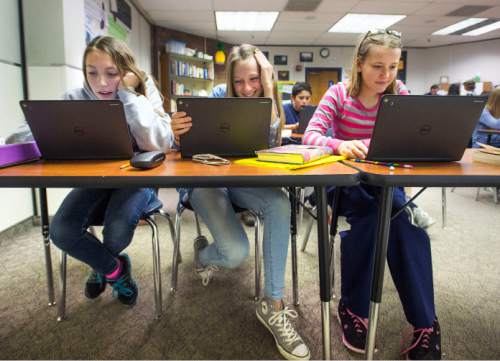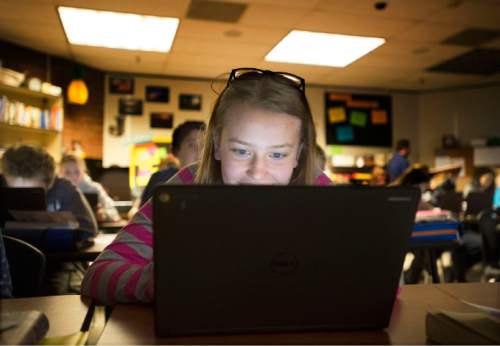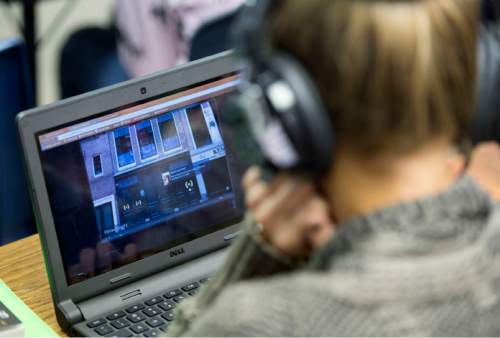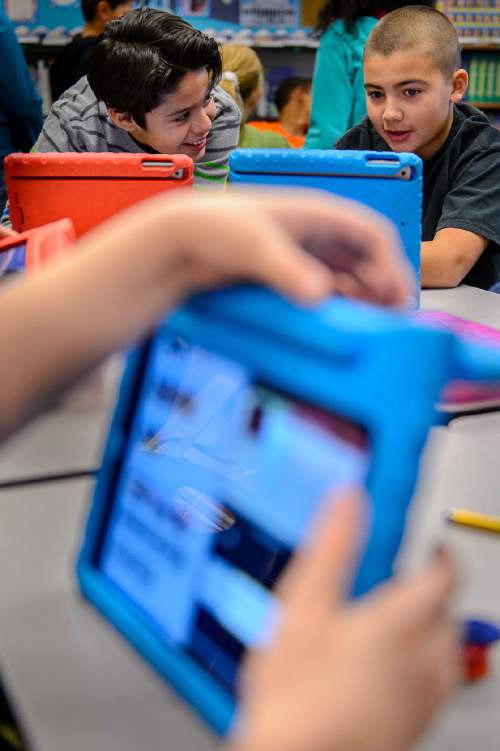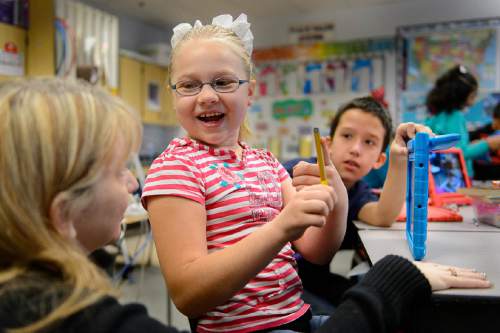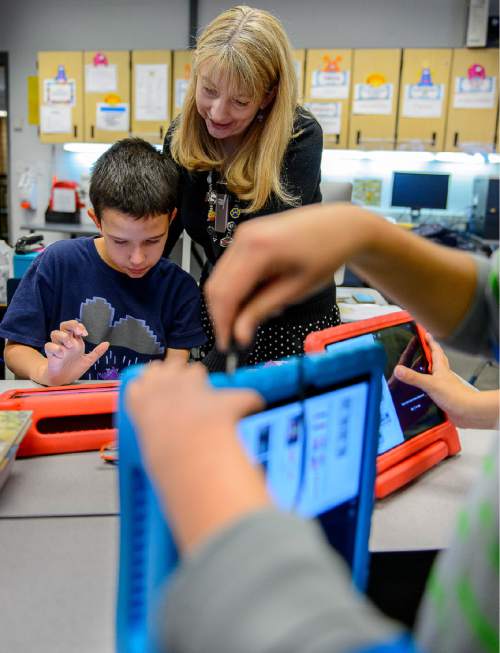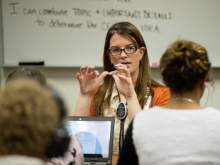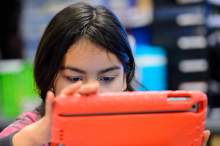This is an archived article that was published on sltrib.com in 2015, and information in the article may be outdated. It is provided only for personal research purposes and may not be reprinted.
Pleasant Grove • Last month, Melinda Johnston's eighth-grade students toured the Anne Frank House in Amsterdam.
The Pleasant Grove Junior High School class took note of details as their guide explained how the Frank family spent two years in rooms concealed by a bookcase during the Nazi occupation of the Netherlands.
"I want a house like this," one student said.
The classmates were able to explore the historic space from the comfort of their desks in Utah County, almost 5,000 miles away.
A laptop screen provided the images while a recorded voice led each student down the corridor, past the bookcase and into the secret annex where Frank wrote her famous diary.
"There are so many resources at our fingertips," Johnston said of the technology in her classroom. "The kids are more engaged."
Pleasant Grove Junior High is one of three schools in Alpine School District that this year launched a one-to-one technology program, in which a learning device is provided for each student.
In its current form, the pilot program is used only by the English departments at those schools. The iPads, Johnston said, are an invaluable resource for the reading- and writing-heavy subject.
"English feedback can be difficult," she said. "They write an essay and it takes a week to grade it, but now we can look immediately at what they're doing."
Eleven of Utah's 41 school districts have launched technology initiatives, according to Rick Gaisford, a technology specialist with the Utah Office of Education.
But state education managers hope to take a major step toward a statewide one-to-one program this January, when lawmakers debate a $100 million school-technology program.
If approved and, more tellingly, if funded, Utah's Essential Elements plan will create one of the most comprehensive school-technology initiatives in the country, Gaisford said.
"We know the world that the kids live in," he said. "We know what they're going to need to be prepared for. Let's make sure our [education] system is able to do exactly that."
—
Digital dollars • School technology is a frequent topic of debate in Utah's Legislature.
Most lawmakers and educators agree on a need for learning devices, but the cost of equipping more than 600,000 students with a laptop or iPad is substantial, particularly for a state that ranks lowest in the nation in per-pupil spending.
In 2014, lawmakers were told by fiscal analysts that putting an electronic device in the hands of every student would cost between $177 million and $434 million.
The price range depends on the type of device purchased and what improvements, such as additional Internet bandwidth, need to be made to the schools.
And Jessie Bushman, another teacher at Pleasant Grove Junior High, points out that any investment in technology demands training for educators.
"You can't just throw computers at us," she said, "and expect us to know how to use them well."
Bushman said the influx of technology in her classroom last fall made her feel like a first-year teacher.
She said the switch affected everything from her lesson plans to the way she organizes and operates her classroom.
"It changes the way you teach," she said, "and you have to have time to explore that and learn how to do that."
Her district's $300,000 pilot program, at three schools, includes ongoing training for English teachers, who meet once each month to review and strategize.
"We're seeing a lot of great things happening with the teachers in those classrooms," said Blaine Edman, Alpine School District's director of technology. "We really want them to be collaborative devices where students are going to work together."
The program also beefed up the wireless Internet capacity at three schools and bought 900 Dell Chromebooks, according to Edman.
The state's schools and school districts have relied on a patchwork of funding sources to launch technology initiatives. As a result, Gaisford said, the availability of learning devices varies throughout the state, from full one-to-one operations to limited pilot programs.
Under the Essential Elements plan, every school would be able to submit a grant proposal to the state, Gaisford said, and state education managers would work with local administrators to refine plans until each application is accepted.
"They all have a compelling need to move an initiative like this forward," Gaisford said.
But learning devices don't come cheap, and Utah has more than 633,000 public education students.
Gaisford acknowledged that $100 million is not enough to give a learning device to all Utah students.
But many districts would be able to complete their one-to-one rollouts, he said, and ongoing funding would reach the remaining students in future years.
"We're not trying to turn education over to a device," he said. "We're trying to empower teachers to be able to take advantage of the technology to really transform the way they can deliver content and instruction."
Back at Pleasant Grove Junior High, Johnston and Bushman said they've seen that transformation firsthand.
For the Anne Frank lesson, students worked in groups and typed answers on a shared Google document projected on the screen that showed the classroom edits in real time.
As the document filled with text, Johnston would highlight exceptional work, simultaneously offering praise to a student while giving peers a standard for which to aim.
"I love the fact that students can see each other's work," she said. "It makes a difference in the quality."
—
No going back • At Salt Lake City's Newman Elementary this month, a fifth-grade class used iPads and the video-editing program iMovie to create movie trailers about magnets.
Brooklyn Booth finished her assignment quickly, and then kept herself occupied by playing one of educational apps installed on the device.
She said a program called ST Math is her favorite, because it uses images rather than text to present problems.
"It doesn't tell you how to do it," she said. "It makes you learn how to do it."
Booth's teacher, Angelique Morrill, has used the iPads for two years and said she prefers them to laptop and desktop computers. Each device is ensconced in a protective rubber case with a handle that doubles as a stand.
"They carry them to other classrooms and use them in the library," Morrill said. "They're really easy to move around."
At the end of class, Booth and her classmates stored the iPads in a locked cabinet.
"They were thinking about letting us take them [home]," Booth said. "But if we didn't bring them back, they'd be lost and we'd get in trouble."
In addition to the initial purchasing costs, one-to-one programs require ongoing funding to replace devices that are lost, stolen, broken or succumb to wear and tear.
That leads many administrators to decide that the devices remain behind when students head home at day's end.
It can create a disconnect between digital classwork and analog homework, Edman said, but reduces the liability for expensive hardware.
"For now, we're keeping those in the classroom," he said. "There's a lot of additional considerations when you start to work with students taking them home."
After two years, Morrill said, she hasn't lost a single iPad to damage or misplacement.
Alpine needed to replace a few defective Chromebooks, Edman said, but so far students have been respectful and careful with the technology.
"From what I understand," he said, "we haven't had any that have been damaged by a student."
Damage aside, the relatively short life of learning technology is part of the high cost of one-to-one initiatives, Gaisford said.
Of the $100 million requested for Essential Elements, $50 million would be a one-time appropriation, with the remaining $50 million repeating each year.
"One-time funding buys a lot of things," Gaisford said, "but it doesn't sustain them."
Edman said Alpine's pilot program could be expanded if funding were available, but is intended to continue at least for the three schools currently participating.
The schools may need to provide matching funds to replace and update the Chromebooks, he said, but it would be challenging to ask teachers to revert to technology-free classrooms.
"This is the way that things are done now at these schools," he said.
Johnston is aware that the Chromebooks may not be permanent, but her plan is to enjoy them while they last.
It would be hard to lose the technology, she said, but teachers would adapt the same way they did when the devices were introduced.
Morrill's students still use paper and pencil on many assignments, particularly in math, so that she can see their work.
But, she said, it would be hard to go back to a technology-free classroom after adapting to learning devices.
"You can see that the students are involved and excited and want to use the technology to show what they know."
bwood@sltrib.com Twitter: @bjaminwood


